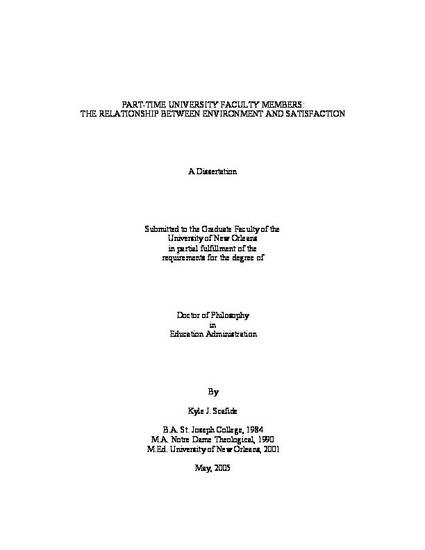
The purpose of this study was to explore the relationship between the environment and the satisfaction of certain part-time university faculty members. A web-based, confidential questionnaire was made available to voluntary participants. The data collection occurred during the Fall semester of 2004. The survey provided data from 10 Louisiana universities in the top four Carnegies categories of Doctoral Extensive, Doctoral Intensive, and Masters I and II universities. Though a total of 610 faculty members participated in this study, the final sample included 542 participants. The research questions of this study focused on job status (part-time or full-time) and academic discipline (liberal arts or business). These were the two major categories from which participants were solicited and into which the participating faculty members were divided. The research utilized Benjamin's (1998) categorization on what he considered to be two "umbrella" groups of faculty members: liberal artsrelated disciplines and vocationally-related disciplines. This latter cluster was represented in this study by colleges of business, which fit into that category. The study also used Linda Hagedorn's (2000) conceptual framework, which contends that certain motivators, hygienes, triggers, and environmental factors have a significant relationship to faculty satisfaction. Her framework is based in large part upon Herzberg's (1959) work, which developed the concept of motivators and hygienes as significant predictors of worker satisfaction. Hagedorn's conceptual framework was modified to address certain environmental conditions that are unique to part-time faculty members. The regression models for both full-time and part-time faculty are highly significant (p = .001) and account for 52.6% of the variance in the full-time population and 64.6% for the parttimers. Six variables indicated significant differences between full-time faculty and part-time faculty, five at the .001 level. Four variables indicated significant differences between liberal arts and business faculty: climate of the university (p <.01), climate of the college (p < .05), climate within the department (p <.05), and overall satisfaction between Benjamin’s (1998) categories.
Available at: http://works.bepress.com/kylescafide/1/
